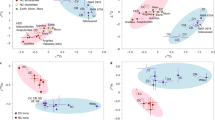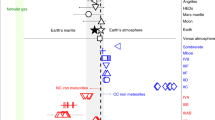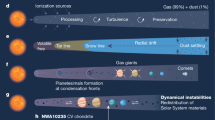Abstract
The relative proportion of the two isotopes of nitrogen, 14N and 15N, varies dramatically across the Solar System, despite little variation on Earth. NASA's Genesis mission directly sampled the solar wind and confirmed that the Sun — and, by inference, the protosolar nebula from which the Solar System formed — is highly depleted in the heavier isotope compared with the reference nitrogen isotopic composition, that of Earth's atmosphere. In contrast, the inner planets, asteroids, and comets are enriched in 15N by tens to hundreds of per cent; organic matter in primitive meteorites records the highest 15N/14N isotopic ratios. The measurements indicate that the protosolar nebula, inner Solar System, and cometary ices represent three distinct isotopic reservoirs, and that the 15N enrichment generally increases with distance from the Sun. The 15N enrichments were probably not inherited from presolar material, but instead resulted from nitrogen isotope fractionation processes that occurred early in Solar System history. Improvements in analytical techniques and spacecraft observations have made it possible to measure nitrogen isotopic variability in the Solar System at a level of accuracy that offers a window into the processing of early Solar System material, large-scale disk dynamics and planetary formation processes.
This is a preview of subscription content, access via your institution
Access options
Subscribe to this journal
Receive 12 print issues and online access
$259.00 per year
only $21.58 per issue
Buy this article
- Purchase on Springer Link
- Instant access to full article PDF
Prices may be subject to local taxes which are calculated during checkout


Similar content being viewed by others
References
Boss, A. P. & Goswami, J. N. in Meteorites and the Early Solar System II (eds Lauretta, D. S. & McSween, H. Y.) 171–186 (Univ. Arizona Press, 2006).
Warren, P. H. Stable-isotopic anomalies and the accretionary assemblage of the Earth and Mars: A subordinate role for carbonaceous chondrites. Earth Planet. Sci. Lett. 311, 93–100 (2011).
Zinner, E. et al. NanoSIMS isotopic analysis of small presolar grains: Search for Si3N4 grains from AGB stars and Al and Ti isotopic compositions of rare presolar SiC grains. Geochim. Cosmochim. Acta 71, 4786–4813 (2007).
Clayton, R. N. Isotopes: from Earth to the solar system. Annu. Rev. Earth Planet. Sci. 35, 1–19 (2007).
Rodgers, S. D. & Charnley, S. B. Nitrogen superfractionation in dense cloud cores. Mon. Not. R. Astron. Soc. 385, L48–L52 (2008).
Robert, F. The D/H ratio in chondrites. Space Sci. Rev. 106, 87–101 (2003).
Robert, F., Gautier, D. & Dubrulle, B. The solar system D/H ratio: Observations and theories. Sp. Sci. Rev. 92, 201–224 (2000).
Deloule, E., Robert, F. & Doukhan, J. C. Interstellar hydroxyl in meteoritic chondrules: Implications for the origin of water in the inner solar system. Geochim. Cosmochim. Acta 62, 3367–3378 (1998).
Bockelée-Morvan, D., Crovisier, J., Mumma, M. J. & Weaver, H. A. in Comets II (Festou, M. C., Keller, H. U. & Weaver, H. A.) 391–423 (Univ. Arizona Press, 2004).
Hartogh, P. et al. Ocean-like water in the Jupiter-family comet 103P/Hartley 2. Nature 478, 218–220 (2011).
Altwegg, K. et al. 67P/Churyumov-Gerasimenko, a Jupiter family comet with a high D/H ratio. Science 347, 1261952 (2015).
Jacquet, E. & Robert, F. Water transport in protoplanetary disks and the hydrogen isotopic composition of chondrites. Icarus 223, 722–732 (2013).
Nier, A. A redetermination of the relative abundances of the isotopes of carbon, nitrogen, oxygen, argon, and potassium. Phys. Rev. 77, 789–793 (1950).
Cartigny, P. & Marty, B. Nitrogen isotopes and mantle geodynamics: the emergence of life and the atmosphere-crust-mantle connection. Elements 9, 359–366 (2013).
Audouze, J., Lequeux, J. & Vigroux, L. Isotopes of carbon, nitrogen and oxygen as probes of nucleosynthesis, stellar mass losses and galactic evolution. Astron. Astrophys. 43, 71–83 (1975).
Chin, Y., Henkel, C., Langer, N. & Mauersberger, R. The detection of extragalactic 15N: consequences for nitrogen nucleosynthesis and chemical evolution. Astrophys. J. 512, L143–L146 (1999).
Adande, G. R. & Ziurys, L. M. Millimeter-wave observations of CN and HNC and their 15N isotopologues: a new evaluation of the 14N/15N ratio across the galaxy. Astrophys. J. 744, 194 (2012).
Dahmen, G., Wilson, T. L. & Matteucci, F. The nitrogen isotope abundance in the Galaxy, I. The Galactic disk gradient. Astron. Astrophys. 295, 194–198 (1995).
Hily-Blant, P., Bonal, L., Faure, a. & Quirico, E. The 15N-enrichment in dark clouds and Solar System objects. Icarus 223, 582–590 (2013).
Bizzocchi, L., Caselli, P. & Dore, L. Detection of N15NH+ in L1544. Astron. Astrophys. 510, L5 (2010).
Gerin, M. et al. Detection of 15NH2D in dense cores: A new tool for measuring the 14N/15N ratio in the cold ISM. Astron. Astrophys. 498, L9–L12 (2009).
Lis, D. C., Wootten, A., Gerin, M. & Roueff, E. Nitrogen isotopic fractionation in interstellar ammonia. Astrophys. J. Lett. 710, L49–L52 (2010).
Wielen, R. & Wilson, T. L. The evolution of the C, N, and O isotope ratios from an improved comparison of the interstellar medium with the Sun. Astron. Astrophys. 142, 139–142 (1997).
Briani, G. et al. Pristine extraterrestrial material with unprecedented nitrogen isotopic variation. Proc. Natl Acad. Sci. USA 106, 10522–10527 (2009).
Hashizume, K., Chaussidon, M., Marty, B. & Terada, K. Protosolar carbon isotopic composition: implications for the origin of meteoritic organics. Astrophys. J. 600, 480–484 (2004).
Fouchet, T. et al. ISO-SWS observations of Jupiter: measurement of the ammonia tropospheric profile and of the 15N/14N isotopic ratio. Icarus 143, 223–243 (2000).
Owen, T., Mahaffy, P. R., Niemann, H. B., Atreya, S. & Wong, M. Protosolar nitrogen. Astrophys. J. 553, L77–L79 (2001).
Meibom, A. et al. Nitrogen and carbon isotopic composition of the Sun inferred from a high-temperature solar nebular condensate. Astrophys. J. 656, L33–L36 (2007).
Burnett, D. S. & Genesis Sci, T. Solar composition from the Genesis Discovery Mission. Proc. Natl Acad. Sci. USA 108, 19147–19151 (2011).
Marty, B. et al. Nitrogen isotopes in the recent solar wind from the analysis of Genesis targets: Evidence for large scale isotope heterogeneity in the early solar system. Geochim. Cosmochim. Acta 74, 340–355 (2010).
Marty, B., Chaussidon, M., Wiens, R. C., Jurewicz, A. J. G. & Burnett, D. S. A 15N-poor isotopic composition for the solar system as shown by Genesis solar wind samples. Science 332, 1533–1536 (2011).
Becker, R. H. & Clayton, R. N. Nitrogen abundances and isotopic compositions in lunar samples. Proc. Lunar Sci. Conf. 6th 2131–2149 (1975).
Kerridge, J. F. Solar nitrogen: Evidence for a secular change in the ratio of nitrogen-15 to nitrogen-14. Science 188, 162–164 (1975).
Bogard, D. D., Nyquist, L., Hirsch, W. C. & Moore, D. Trapped solar and cosmogenic noble gas abundances in Apollo 15 and 16 deep drill samples. Earth Planet. Sci. Lett. 21, 52–69 (1973).
Clayton, R. N. & Thiemens, M. H. in The Ancient Sun: Fossil Record in the Earth, Moon and Meteorites (eds Pepin, R. O. et al.) 463–473 (Pergamon, 1980).
Geiss, J. & Bochsler, P. Nitrogen isotopes in the solar system. Geochim. Cosmochim. Acta 46, 529–548 (1982).
Wieler, R. The solar noble gas record in lunar samples and meteorites. Space Sci. Rev. 85, 303–314 (1998).
Wieler, R., Humbert, F. & Marty, B. Evidence for a predominantly non-solar origin of nitrogen in the lunar regolith revealed by single grain analyses. Earth Planet. Sci. Lett. 167, 47–60 (1999).
Hashizume, K., Marty, B. & Wieler, R. Analyses of nitrogen and argon in single lunar grains: towards a quantification of the asteroidal contribution to planetary surfaces. Earth Planet. Sci. Lett. 202, 201–216 (2002).
Füri, E., Marty, B. & Assonov, S. S. Constraints on the flux of meteoritic and cometary water on the Moon from volatile element (N-Ar) analyses of single lunar soil grains, Luna 24 core. Icarus 218, 220–229 (2012).
Hashizume, K., Chaussidon, M., Marty, B. & Robert, F. Solar wind record on the Moon: deciphering presolar from planetary nitrogen. Science 290, 1142–1145 (2000).
Ozima, M. et al. Terrestrial nitrogen and noble gases in lunar soils. Nature 436, 655–659 (2005).
Fletcher, L. N. et al. The origin of nitrogen on Jupiter and Saturn from the 15N/14N ratio. Icarus 238, 170–190 (2014).
Owen, T. et al. A low-temperature origin for the planetesimals that formed Jupiter. Nature 402, 269–270 (1999).
Kerridge, J. F., Eugster, O., Kim, J. S. & Marti, K. Nitrogen isotopes in the 74001/74002 double-drive tube from Shorty Crater, Apollo 17. Proc. 21st Lunar Planet. Sci. Conf. 54, 291–299 (1991).
Mathew, K. J. & Marti, K. Early evolution of Martian volatiles: Nitrogen and noble gas components in ALH84001 and Chassigny. J. Geophys. Res. 106, 1401–1422 (2001).
Hoffman, J. H., Oyama, V. I. & von Zahn, U. Measurements of the Venus lower atmosphere composition: A comparison of results. J. Geophys. Res. 85, 7871 (1980).
Alexander, C. M. O. et al. The origin of chondritic macromolecular organic matter: A carbon and nitrogen study. Meteorit. Planet. Sci. 33, 603–622 (1998).
Robert, F. & Epstein, S. The concentration and isotopic composition of hydrogen, carbon and nitrogen in carbonaceous meteorites. Geochim. Cosmochim. Acta 46, 81–95 (1982).
Kerridge, J. F. Carbon, hydrogen and nitrogen in carbonaceous chondrites: abundances and isotopic compositions in bulk samples. Geochim. Cosmochim. Acta 49, 1707–1714 (1985).
Weisberg, M. et al. The CR chondrite clan. Proc. NIPR Symp. Antart. Meteorites 8, 11–32 (1995).
Grady, M. M. & Pillinger, C. T. ALH 85085: nitrogen isotope analysis of a highly unusual primitive chondrite. Earth Planet. Sci. Lett. 97, 29–40 (1990).
Prombo, C. A. & Clayton, R. N. A striking nitrogen isotope anomaly in the Bencubbin and Weatherford meteorites. Science 230, 935–937 (1985).
Marty, B., Kelley, S. & Turner, G. Chronology and shock history of the Bencubbin meteorite: A nitrogen, noble gas, and Ar–Ar investigation of silicates, metal and fluid inclusions. Geochim. Cosmochim. Acta 74, 6636–6653 (2010).
Ivanova, M. A. et al. The Isheyevo meteorite: Mineralogy, petrology, bulk chemistry, oxygen, nitrogen, carbon isotopic compositions, and 40Ar-39Ar ages. Meteorit. Planet. Sci. 43, 915–940 (2008).
Bonal, L. et al. Highly 15N-enriched chondritic clasts in the CB/CH-like meteorite Isheyevo. Geochim. Cosmochim. Acta 74, 6590–6609 (2010).
Busemann, H. et al. Interstellar chemistry recorded in organic matter from primitive meteorites. Science 312, 727–730 (2006).
Aléon, J., Robert, F., Chaussidon, M. & Marty, B. Nitrogen isotopic composition of macromolecular organic matter in interplanetary dust particles. Geochim. Cosmochim. Acta 67, 3773–3783 (2003).
Nakamura-Messenger, K., Messenger, S., Keller, L. P., Clemett, S. J. & Zolensky, M. E. Organic globules in the Tagish Lake meteorite: remnants of the protosolar disk. Science 314, 1439–1442 (2006).
Brownlee, D. E. The Stardust mission: Analyzing samples from the edge of the solar system. Annu. Rev. Earth Planet. Sci. 42, 179–205 (2014).
Brownlee, D. Comet 81P/Wild 2 under a microscope. Science 314, 1711–1716 (2006).
McKeegan, K. D. et al. Isotopic compositions of cometary matter returned by Stardust. Science 314, 1724–8 (2006).
Stadermann, F. J. et al. Stardust in Stardust—the C, N, and O isotopic compositions of Wild 2 cometary matter in Al foil impacts. Meteor. Planet. Sci. 313, 299–313 (2008).
Arpigny, C. et al. Anomalous nitrogen isotope ratio in comets. Science 301, 1522–1524 (2003).
Jehin, E., Manfroid, J., Hutsemékers, D., Arpigny, C. & Zucconi, J-M. Isotopic ratios in comets: status and perspectives. Earth. Moon Planets 105, 167–180 (2009).
Bockelée-Morvan, D. et al. Large excess of heavy nitrogen in both hydrogen cyanide and cyanogen from comet 17P/Holmes. Astrophys. J. 679, L49–L52 (2008).
Rousselot, P. et al. Toward a unique nitrogen isotopic ratio in cometary ices. Astrophys. J. 780, L17 (2014).
Shinnaka, Y., Kawakita, H., Kobayashi, H., Nagashima, M. & Boice, D. C. 14NH2/15NH2 ratio in comet C/2012 S1 (Ison) observed during its outburst in 2013 November. Astrophys. J. 782, L16 (2014).
Duncan, M. J. & Levison, H. F. A disk of scattered icy objects and the origin of Jupiter-family comets. Science 276, 1670–1672 (1997).
Carusi, A., Kresák, L., Perozzi, E. & Valsecchi, G. B. High-order librations of Halley-type comets. Astron. Astrophys. 187, 899–905 (1987).
Füri, E., Chaussidon, M. & Marty, B. Evidence for an early nitrogen isotopic evolution in the solar nebula from volatile analyses of a CAI from the CV3 chondrite NWA 8616. Geochim. Cosmochim. Acta 153, 183–201 (2015).
Terzieva, R. & Herbst, E. The possibility of nitrogen isotopic fractionation in interstellar clouds. Mon. Not. R. Astron. Soc. 317, 563–568 (2000).
Charnley, S. B. & Rodgers, S. D. The end of interstellar chemistry as the origin of nitrogen in comets and meteorites. Astrophys. J. Lett. 569, L133–L137 (2002).
Chakraborty, S. et al. Massive isotopic effect in vacuum UV photodissociation of N2 and implications for meteorite data. Proc. Natl Acad. Sci. USA 111, 14704–14709 (2014).
Aléon, J. Multiple origins of nitrogen isotopic anomalies in meteorites and comets. Astrophys. J. 722, 1342–1351 (2010).
Marty, B. The origins and concentrations of water, carbon, nitrogen and noble gases on Earth. Earth Planet. Sci. Lett. 313–314, 56–66 (2012).
Füri, E., Deloule, E., Gurenko, A. & Marty, B. New evidence for chondritic lunar water from combined D/H and noble gas analyses of single Apollo 17 volcanic glasses. Icarus 229, 109–120 (2014).
Grinspoon, D. H. Implications of the high D/H ratio for the sources of water in Venus' atmosphere. Nature 363, 428–431 (1993).
Leshin, L. A. Insights into martian water reservoirs from analyses of martian meteorite QUE94201. Geophys. Res. Lett. 27, 2017–2020 (2000).
Leshin, L. A. et al. Volatile, isotope, and organic analysis of martian fines with the Mars Curiosity rover. Science 341, 1238937 (2013).
Alexander, C. M. O., Fogel, M., Yabuta, H. & Cody, G. D. The origin and evolution of chondrites recorded in the elemental and isotopic compositions of their macromolecular organic matter. Geochim. Cosmochim. Acta 71, 4380–4403 (2007).
Macy, W. & Smith, W. H. Detection of HD on Saturn and Uranus, and the D/H ratio. Astrophys. J. 222, L73 (1978).
Mahaffy, P. R., Donahue, T. M., Atreya, S. K., Owen, T. C. & Niemann, H. B. Galileo probe measurements of D/H and3He/4He in Jupiter's atmosphere. Space Sci. Rev. 84, 251–263 (1998).
Niemann, H. B. et al. Composition of Titan's lower atmosphere and simple surface volatiles as measured by the Cassini-Huygens probe gas chromatograph mass spectrometer experiment. J. Geophys. Res. 115, E12006 (2010).
Ceccarelli, C. et al. in Protostars and Planets VI: Part IV: Astrophysical conditions for life (eds Beuther, H. et al.) 859–882 (University of Arizona Press, 2014).
Manfroid, J. et al. The CN isotopic ratios in comets. Astron. Astrophys. 503, 613–624 (2009).
Javoy, M. & Pineau, F. The volatiles record of a “popping” rock from the Mid-Atlantic Ridge at 14°N: chemical and isotopic composition of gas trapped in the vesicles. Earth Planet. Sci. Lett. 107, 598–611 (1991).
Hashizume, K. & Marty, B. in Handbook of Stable Isotope Analytical Techniques (ed. de Groot, P. A.) 361–375 (Elsevier Science, 2004).
Barry, P. H., Hilton, D. R., Halldórsson, S. A., Hahm, D. & Marti, K. High precision nitrogen isotope measurements in oceanic basalts using a static triple collection noble gas mass spectrometer. Geochem. Geophys. Geosyst. 13, Q01019 (2012).
Hauri, E. H., Wang, J., Pearson, D. G. & Bulanova, G. P. Microanalysis of δ13C, δ15N, and N abundances in diamonds by secondary ion mass spectrometry. Chem. Geol. 185, 149–163 (2002).
Rubin, M. et al. Molecular nitrogen in comet 67P/Churyumov– Gerasimenko indicates a low formation temperature. Science (2015).
Adams, N. G. & Smith, D. 14N/15N isotope fractionation in the reaction N2H+ + N2: Interstellar significance. Astrophys. J. 247, L123–L125 (1981).
Geppert, W. D. et al. Dissociative recombination of N2H+: evidence for fracture of the N-N Bond. Astrophys. J. 609, 459–464 (2004).
Molek, C. D., McLain, J. L., Poterya, V. & Adams, N. G. A remeasurement of the products for electron recombination of N2H+ using a new technique: no significant NH + N production. J. Phys. Chem. A 111, 6760–6765 (2007).
Clayton, R. N. Self-shielding in the solar nebula. Nature 415, 860–861 (2002).
Muskatel, B. H., Remacle, F., Thiemens, M. H. & Levine, R. D. On the strong and selective isotope effect in the UV excitation of N2 with implications toward the nebula and Martian atmosphere. Proc. Natl Acad. Sci. USA 108, 6020–6025 (2011).
Davis, A. M. et al. in Protostars and Planets VI (eds Beuther, H. et al.) 809–831 (Univ. Arizona Press, 2015).
Alexander, C. M. O. et al. The provenances of asteroids, and their contributions to the volatile inventories of the terrestrial planets. Science 337, 721–723 (2012).
Acknowledgements
Discussions with J. Aléon, K. Altwegg, D. Bockelée-Morvan, P. Cartigny, M. Chaussidon, K. Mandt, O. Mousis, and F. Robert were much appreciated during the preparation of this work. This work was supported by the European Research Council under the European Community's Seventh Framework Programme (FP7/2007-2013 grant agreement no. 267255 to B.M.), the Deep Carbon Observatory, and the CNRS-INSU Programme de Planétologie (PNP). This is CRPG-CNRS contribution 2372.
Author information
Authors and Affiliations
Corresponding authors
Ethics declarations
Competing interests
The authors declare no competing financial interests.
Rights and permissions
About this article
Cite this article
Füri, E., Marty, B. Nitrogen isotope variations in the Solar System. Nature Geosci 8, 515–522 (2015). https://doi.org/10.1038/ngeo2451
Received:
Accepted:
Published:
Issue Date:
DOI: https://doi.org/10.1038/ngeo2451
This article is cited by
-
Nitrogen K-edge X-ray adsorption near-edge structure spectroscopy of chemically adsorbed ammonia gas on clay minerals and the 15N/14N-nitrogen isotopic fractionation
Analytical Sciences (2024)
-
Distributions of CHN compounds in meteorites record organic syntheses in the early solar system
Scientific Reports (2023)
-
A Comparison of Presolar Isotopic Signatures in Laboratory-Studied Primitive Solar System Materials and Comet 67P/Churyumov-Gerasimenko: New Insights from Light Elements, Halogens, and Noble Gases
Space Science Reviews (2023)
-
Nitrogen isotopic ratio and abundance in selected ordinary chondrites: clues for their formation in proto-planetary disk
Astrophysics and Space Science (2023)
-
Influx of nitrogen-rich material from the outer Solar System indicated by iron nitride in Ryugu samples
Nature Astronomy (2023)



